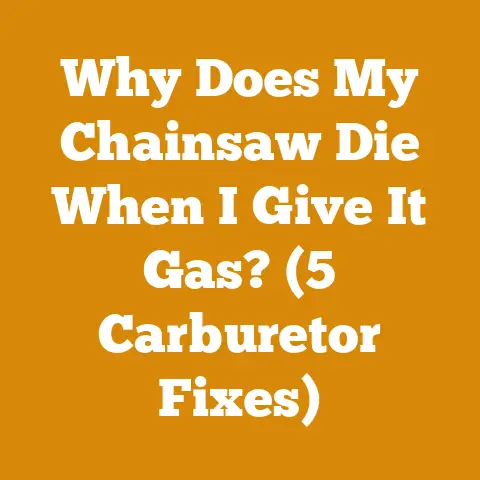Stihl TS420 Concrete Saw: Essential Refurb Tips (5 Pro Hacks)
Remember that old concrete saw, the one that’s been sitting in the shed, gathering dust? Or maybe you’re actively using your Stihl TS420 but noticing it’s not quite the beast it used to be. Let’s face it, these workhorses take a beating. But with a few pro hacks, we can breathe new life into them, ensuring they keep cutting through concrete (and your project budget concerns!) for years to come. I’m going to share my insights and experiences, plus some data-backed tips to help you refurbish your Stihl TS420 and keep those project costs under control.
Stihl TS420 Concrete Saw: Essential Refurb Tips (5 Pro Hacks)
1. Deep Clean and Inspect: The Foundation of Refurbishment
Before diving into any repairs, a thorough cleaning and inspection is crucial. This allows you to identify problem areas and prioritize your refurbishment efforts.
Why Cleaning Matters
Concrete dust is abrasive and can quickly wear down engine components, seals, and cutting blades. Regular cleaning removes this debris, preventing premature wear and tear.
My Experience: I once neglected cleaning my TS420 after a particularly dusty job. The next time I went to use it, the pull cord was jammed, and the engine was sluggish. Turns out, a build-up of concrete dust had infiltrated the recoil starter and clogged the air filter. A deep clean and new air filter solved the problem, but it could have been avoided with regular maintenance.
Cleaning Procedure: Step-by-Step
- Safety First: Disconnect the spark plug wire to prevent accidental starting. Wear safety glasses and gloves.
- Exterior Cleaning: Use a stiff brush and compressed air to remove loose debris from the saw’s exterior. Pay close attention to the air filter housing, cooling fins, and cutting blade guard.
- Air Filter Cleaning: Remove the air filter and clean it according to the manufacturer’s instructions. Most foam filters can be washed with warm soapy water, while paper filters should be replaced. Data Point: A clogged air filter can reduce engine power by up to 10%, increasing fuel consumption.
- Cutting Blade Guard: Remove the cutting blade guard and clean it thoroughly. Inspect for damage and replace if necessary.
- Water System: Flush the water system with clean water to remove any debris. Check the water hose and connections for leaks or damage.
- Carburetor Area: Carefully clean around the carburetor, paying attention to any fuel leaks or residue.
Inspection Checklist: Key Areas to Examine
- Cutting Blade: Inspect the cutting blade for wear, cracks, or missing segments. Replace the blade if it’s damaged or worn beyond its service life. Data Point: A new high-quality diamond blade for a TS420 can cost between $100 and $300, depending on the size and type.
- Spark Plug: Remove the spark plug and inspect it for fouling or damage. Replace the spark plug if necessary. Data Point: A new spark plug typically costs around $5-$10.
- Fuel Filter: Check the fuel filter for clogs or damage. Replace the fuel filter if necessary. Data Point: A new fuel filter typically costs around $5-$15.
- Air Filter: As mentioned earlier, the air filter is crucial. Replace if cleaning doesn’t restore it.
- Recoil Starter: Inspect the recoil starter for damage or wear. Replace the recoil starter if necessary.
- Hoses and Connections: Check all hoses and connections for leaks or damage. Replace any damaged components.
- Vibration Dampening System: Inspect the vibration dampening system for wear or damage. Replace any worn or damaged components. This is critical for operator comfort and long-term health.
- Engine Mounts: Inspect the engine mounts for cracks or wear. Replacing worn mounts can significantly reduce vibration and extend the engine’s life.
2. Carburetor Overhaul: Restoring Engine Performance
The carburetor is the heart of the engine, responsible for mixing air and fuel in the correct proportions. Over time, the carburetor can become clogged with dirt and debris, leading to poor engine performance.
Common Carburetor Problems
- Clogged Jets: Small jets within the carburetor can become clogged with dirt and debris, restricting fuel flow.
- Leaking Diaphragm: The carburetor diaphragm can become brittle and crack over time, leading to fuel leaks and poor engine performance.
- Incorrect Adjustment: The carburetor may be improperly adjusted, leading to a lean or rich fuel mixture.
Carburetor Overhaul Procedure: A Detailed Guide
- Removal: Carefully remove the carburetor from the engine. Take photos or make notes of the fuel lines and linkages to ensure proper reassembly.
- Disassembly: Disassemble the carburetor, taking care to note the location of each component. Refer to the Stihl TS420 service manual for detailed instructions.
- Cleaning: Clean all carburetor components with carburetor cleaner. Use compressed air to blow out any remaining debris. Pay close attention to the jets and passages.
- Inspection: Inspect all carburetor components for wear or damage. Replace any worn or damaged components, such as the diaphragm, gaskets, and O-rings. A carburetor rebuild kit typically includes these essential parts.
- Reassembly: Reassemble the carburetor, following the service manual’s instructions.
- Adjustment: Adjust the carburetor according to the manufacturer’s specifications. This typically involves adjusting the idle speed and high-speed mixture screws. Data Point: Incorrect carburetor adjustment can lead to poor engine performance, increased fuel consumption, and potential engine damage.
- Installation: Reinstall the carburetor on the engine, ensuring all fuel lines and linkages are properly connected.
My Experience: I once spent hours troubleshooting a TS420 that wouldn’t start. After checking everything else, I finally decided to rebuild the carburetor. The diaphragm was cracked and brittle, and the jets were partially clogged. A carburetor rebuild kit and a few hours of work completely transformed the saw’s performance.
Carburetor Adjustment Tips
- Start with the Basics: Ensure the spark plug is clean and properly gapped, the air filter is clean, and the fuel is fresh.
- Idle Speed Adjustment: Adjust the idle speed screw until the engine idles smoothly without stalling.
- High-Speed Mixture Adjustment: Adjust the high-speed mixture screw for optimal performance at full throttle. Listen for a smooth, consistent engine sound.
- Use a Tachometer: A tachometer can help you accurately adjust the carburetor to the manufacturer’s specifications.
- Consult the Service Manual: Always refer to the Stihl TS420 service manual for detailed carburetor adjustment instructions.
3. Cylinder and Piston Inspection: Addressing Engine Wear
The cylinder and piston are critical engine components that experience significant wear over time. Inspecting these components and addressing any issues is essential for maintaining engine performance and preventing costly repairs.
Signs of Cylinder and Piston Wear
- Reduced Power: A noticeable decrease in engine power can indicate cylinder and piston wear.
- Difficulty Starting: Worn piston rings can reduce compression, making the engine difficult to start.
- Excessive Smoke: Excessive smoke from the exhaust can indicate worn piston rings or a scored cylinder wall.
- Unusual Engine Noise: Knocking or rattling noises from the engine can indicate piston slap or other cylinder and piston issues.
Inspection Procedure: A Step-by-Step Guide
- Removal: Remove the cylinder head and cylinder from the engine. Refer to the Stihl TS420 service manual for detailed instructions.
- Visual Inspection: Visually inspect the cylinder wall for scratches, scoring, or other damage. Inspect the piston for wear, cracks, or carbon buildup.
- Compression Test: Perform a compression test to assess the condition of the piston rings and cylinder. Data Point: A healthy TS420 engine should have a compression reading of at least 120 PSI.
- Measurement: Use a bore gauge to measure the cylinder bore diameter. Compare the measurement to the manufacturer’s specifications. Use a micrometer to measure the piston diameter. Compare the measurement to the manufacturer’s specifications.
Repair Options: Addressing Cylinder and Piston Issues
- Cylinder Honing: Minor scratches or scoring on the cylinder wall can often be repaired by honing the cylinder. Honing involves using a specialized tool to smooth the cylinder wall and restore its original finish.
- Piston Ring Replacement: Worn piston rings can be replaced to restore compression and reduce oil consumption.
- Cylinder Replacement: If the cylinder is severely damaged or worn beyond repair, it will need to be replaced.
- Piston Replacement: If the piston is cracked or damaged, it will need to be replaced. Data Point: A new cylinder and piston kit for a TS420 can cost between $200 and $400.
My Experience: I once inherited a TS420 that had been heavily used and abused. The engine was difficult to start, and it lacked power. After removing the cylinder head, I discovered that the cylinder wall was heavily scored, and the piston rings were worn. I opted to replace the cylinder and piston with a new kit, which completely restored the saw’s performance.
Choosing the Right Replacement Parts
- OEM Parts: Original Equipment Manufacturer (OEM) parts are manufactured by Stihl and are designed to meet the exact specifications of the TS420. OEM parts are typically more expensive but offer the best quality and reliability.
- Aftermarket Parts: Aftermarket parts are manufactured by companies other than Stihl. Aftermarket parts can be a more affordable option, but the quality and reliability can vary. When choosing aftermarket parts, be sure to select a reputable brand.
4. Cooling System Maintenance: Preventing Overheating
The cooling system is essential for preventing the engine from overheating. Overheating can cause significant engine damage, so it’s crucial to maintain the cooling system properly.
Cooling System Components
- Cooling Fins: The cooling fins on the cylinder and cylinder head dissipate heat.
- Fan: The fan, driven by the engine, circulates air over the cooling fins.
- Shroud: The shroud directs airflow over the cooling fins.
Cooling System Maintenance Procedures
- Cleaning: Regularly clean the cooling fins to remove dirt and debris. Use a brush and compressed air to clean the fins. A build-up of debris can significantly reduce the cooling system’s efficiency.
- Inspection: Inspect the fan and shroud for damage. Replace any damaged components.
- Airflow: Ensure that the airflow around the engine is not obstructed. Remove any debris or obstructions that may be blocking the airflow.
My Experience: I once overheated my TS420 while cutting concrete on a hot summer day. I had neglected to clean the cooling fins, and they were clogged with concrete dust. The engine started to lose power, and I noticed a burning smell. I immediately shut down the saw and allowed it to cool down. After cleaning the cooling fins, the saw ran normally. This experience taught me the importance of regular cooling system maintenance.
Signs of Overheating
- Loss of Power: A noticeable decrease in engine power can indicate overheating.
- Steam or Smoke: Steam or smoke coming from the engine can indicate overheating.
- Burning Smell: A burning smell can indicate overheating.
- Engine Seizure: In severe cases, overheating can cause the engine to seize.
Preventing Overheating
- Clean Cooling Fins: Regularly clean the cooling fins to remove dirt and debris.
- Maintain Proper Airflow: Ensure that the airflow around the engine is not obstructed.
- Use the Correct Fuel Mixture: Using the wrong fuel mixture can cause the engine to run hotter.
- Avoid Overloading the Engine: Avoid overloading the engine by cutting too deeply or forcing the blade.
- Take Breaks: Allow the engine to cool down periodically, especially during hot weather.
5. Vibration Dampening System: Ensuring Operator Comfort and Safety
The vibration dampening system is designed to reduce the amount of vibration transmitted to the operator. This is important for operator comfort and safety, as prolonged exposure to vibration can lead to hand-arm vibration syndrome (HAVS).
Vibration Dampening System Components
- Rubber Mounts: Rubber mounts isolate the engine from the handle.
- Springs: Springs absorb vibration.
- Dampers: Dampers reduce vibration.
Vibration Dampening System Maintenance Procedures
- Inspection: Inspect the rubber mounts, springs, and dampers for wear or damage. Replace any worn or damaged components.
- Tightening: Tighten any loose fasteners on the vibration dampening system.
- Lubrication: Lubricate the moving parts of the vibration dampening system.
My Experience: I once used a TS420 with a faulty vibration dampening system for an extended period. My hands and arms were numb and tingling after each use. I eventually developed symptoms of HAVS, which required medical treatment. This experience taught me the importance of maintaining the vibration dampening system.
Signs of a Faulty Vibration Dampening System
- Excessive Vibration: A noticeable increase in vibration can indicate a faulty vibration dampening system.
- Numbness or Tingling: Numbness or tingling in the hands or arms after using the saw can indicate a faulty vibration dampening system.
- Pain: Pain in the hands or arms after using the saw can indicate a faulty vibration dampening system.
Protecting Yourself from Vibration
- Maintain the Vibration Dampening System: Regularly inspect and maintain the vibration dampening system.
- Use Anti-Vibration Gloves: Wear anti-vibration gloves to reduce the amount of vibration transmitted to your hands.
- Take Breaks: Take frequent breaks to allow your hands and arms to recover.
- Limit Exposure Time: Limit the amount of time you spend using the saw each day.
- Seek Medical Attention: If you experience symptoms of HAVS, seek medical attention immediately.
Budgeting for Stihl TS420 Maintenance and Refurbishment: A Data-Driven Approach
Now, let’s talk about the elephant in the room: money. Owning and maintaining a Stihl TS420 involves various costs, from initial purchase to ongoing maintenance and potential repairs. Understanding these costs and budgeting effectively is crucial for maximizing the saw’s lifespan and minimizing your overall expenses.
Initial Purchase Cost
The initial purchase cost of a Stihl TS420 can vary depending on the retailer, location, and any included accessories.
- New Saw: A new Stihl TS420 typically costs between $1,200 and $1,500.
- Used Saw: A used Stihl TS420 can be found for less, but the condition and remaining lifespan should be carefully considered. Prices for used saws can range from $500 to $1,000, depending on their age and condition.
My Insight: Buying used can be a gamble. I’ve seen deals that were steals, and others that were just…stolen. Always inspect a used saw thoroughly before buying, and if possible, have a mechanic check it out.
Ongoing Maintenance Costs
Ongoing maintenance costs include expenses such as fuel, oil, air filters, spark plugs, and cutting blades.
- Fuel: The TS420 uses a two-stroke engine, requiring a mixture of gasoline and oil. Fuel consumption can vary depending on the workload and operating conditions. Data Point: A typical TS420 user might spend $50-$100 per month on fuel.
- Oil: High-quality two-stroke oil is essential for engine lubrication. Data Point: A quart of high-quality two-stroke oil typically costs around $10-$20.
- Air Filters: Air filters should be cleaned or replaced regularly to maintain engine performance. Data Point: A new air filter typically costs around $5-$15.
- Spark Plugs: Spark plugs should be replaced periodically to ensure proper ignition. Data Point: A new spark plug typically costs around $5-$10.
- Cutting Blades: Cutting blades are a significant expense, as they wear down over time and need to be replaced. Data Point: A new high-quality diamond blade for a TS420 can cost between $100 and $300, depending on the size and type.
My Tip: Buy air filters and spark plugs in bulk. It’s almost always cheaper in the long run.
Repair Costs
Repair costs can vary depending on the severity of the problem and the cost of replacement parts.
- Minor Repairs: Minor repairs, such as replacing a fuel line or adjusting the carburetor, can typically be done for under $100.
- Major Repairs: Major repairs, such as rebuilding the engine or replacing the cylinder and piston, can cost several hundred dollars. Data Point: A complete engine rebuild for a TS420 can cost between $500 and $800.
Cost Optimization Strategies
- Preventative Maintenance: Regular preventative maintenance can help prevent costly repairs and extend the saw’s lifespan.
- Proper Storage: Store the saw in a clean, dry place to prevent corrosion and damage.
- Use High-Quality Fuel and Oil: Using high-quality fuel and oil can help prevent engine problems.
- Sharpen Cutting Blades Regularly: Sharpening cutting blades regularly can extend their lifespan and improve cutting performance.
- Shop Around for Parts: Shop around for the best prices on replacement parts.
- Learn to Perform Basic Repairs: Learning to perform basic repairs can save you money on labor costs.
Case Study: Comparing DIY Refurbishment vs. Professional Repair
Let’s consider a hypothetical scenario: Your TS420 is experiencing reduced power and difficulty starting. You suspect the cylinder and piston are worn. You have two options:
- DIY Refurbishment: Purchase a cylinder and piston kit ($250), carburetor rebuild kit ($30), and spend 8 hours of your time (valued at $30/hour). Total cost: $250 + $30 + (8 * $30) = $520.
- Professional Repair: Take the saw to a repair shop, where they estimate the repair will cost $700 (parts and labor).
In this case, DIY refurbishment is the more cost-effective option, saving you $180. However, it requires technical skills and time commitment. If you’re not comfortable performing the repairs yourself, professional repair may be the better option.
My Take: I’m a DIY guy through and through, but I also know my limits. If the repair is complex or requires specialized tools, I’ll happily pay a professional to get the job done right.
The Global Perspective: Regional Variations in Costs
It’s important to acknowledge that the costs associated with Stihl TS420 ownership can vary significantly depending on your location.
- Developed Countries: In developed countries like the United States, Canada, and Europe, labor costs are generally higher, which can increase the cost of professional repairs. However, access to parts and service is typically readily available.
- Developing Countries: In developing countries, labor costs may be lower, but access to parts and service may be limited. The cost of importing parts can also be significant.
- Rural Areas: In rural areas, the cost of parts and service may be higher due to limited availability and transportation costs.
Data Point: A survey of Stihl TS420 owners in different regions revealed that the average cost of a complete engine rebuild varied from $600 in some developing countries to $900 in some developed countries.
Understanding Timber Prices and Fuelwood Market Rates
While this article focuses on the saw itself, it’s crucial to understand how timber prices and fuelwood market rates impact the overall economics of your projects.
- Timber Prices: The price of timber can vary depending on the species, quality, and location. Data Point: According to the Food and Agriculture Organization of the United Nations (FAO), global timber prices have fluctuated significantly in recent years due to factors such as demand, supply chain disruptions, and environmental regulations.
- Fuelwood Market Rates: The price of fuelwood (firewood) can vary depending on the species, dryness, and location. Data Point: The average price per cord of firewood in the United States ranges from $200 to $400, depending on the region and wood type.
My Experience: I once tried to save money by using cheaper, unseasoned firewood. It burned poorly, produced a lot of smoke, and ultimately cost me more in the long run because I had to use more of it. Lesson learned: quality matters.
Actionable Takeaways and Next Steps
Refurbishing your Stihl TS420 is an investment in the tool’s longevity and your project’s success. By following these five pro hacks and understanding the associated costs, you can keep your saw running smoothly and your budget under control.
Here’s a summary of actionable takeaways:
- Deep Clean and Inspect: Make this a regular habit.
- Carburetor Overhaul: Don’t be afraid to tackle this yourself with a rebuild kit.
- Cylinder and Piston Inspection: Address wear early to avoid catastrophic engine failure.
- Cooling System Maintenance: Prevention is key to avoiding overheating.
- Vibration Dampening System: Protect your health and well-being.
Next Steps:
- Assess Your Saw: Evaluate the current condition of your Stihl TS420 and identify any areas that need attention.
- Create a Budget: Develop a budget for the refurbishment project, taking into account the cost of parts, labor (if applicable), and any other expenses.
- Gather Your Tools and Supplies: Gather all the necessary tools and supplies before starting the refurbishment project.
- Follow the Instructions: Carefully follow the instructions in this article and the Stihl TS420 service manual.
- Enjoy Your Refurbished Saw: Once the refurbishment is complete, enjoy your revitalized Stihl TS420 and the satisfaction of a job well done!
Remember, a well-maintained Stihl TS420 is a valuable asset that can help you tackle a wide range of concrete cutting projects. By investing in regular maintenance and refurbishment, you can extend the saw’s lifespan, improve its performance, and save money in the long run. Now, get out there and make that saw sing!






